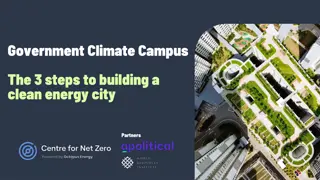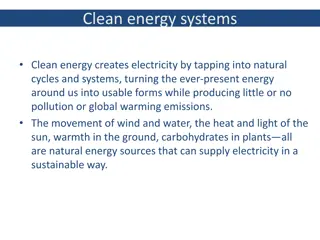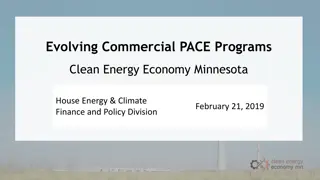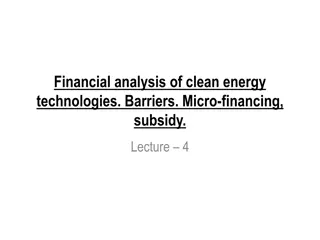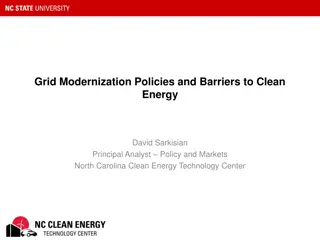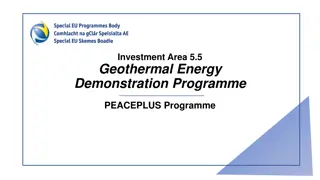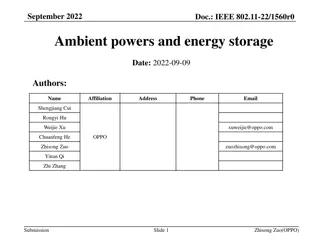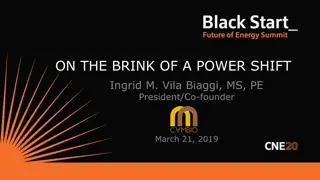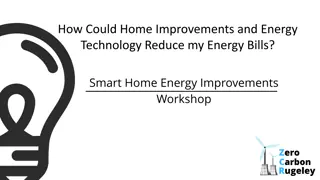Capacity Building on Clean Energy Technologies for Sustainable Development
This course delves into the management of micro-level clean energy projects, focusing on project organization, selection of sustainable technologies, financial analysis, and barriers. It emphasizes affordable, reliable, and accessible clean energy solutions, while empowering consumers and promoting gender equality in rural energy development. Capacity building initiatives include awareness campaigns, human resource development, and research and development on clean energy technologies, with a special focus on biomass.
Download Presentation

Please find below an Image/Link to download the presentation.
The content on the website is provided AS IS for your information and personal use only. It may not be sold, licensed, or shared on other websites without obtaining consent from the author.If you encounter any issues during the download, it is possible that the publisher has removed the file from their server.
You are allowed to download the files provided on this website for personal or commercial use, subject to the condition that they are used lawfully. All files are the property of their respective owners.
The content on the website is provided AS IS for your information and personal use only. It may not be sold, licensed, or shared on other websites without obtaining consent from the author.
E N D
Presentation Transcript
Capacity building of local operators, managers regarding the maintenance of clean energy technologies. Lecture 5
OUTLINE OF COURSE MANAGEMENT OF MICRO LEVEL CLEAN ENERGY PROJECTS Introduction to project management for clean energy system at micro level. Functions of project based management: scope of work, project organization, quality, cost and duration Tools and techniques of project-based management Project life cycle. Processes of project management. Types of management Methods of selecting sustainable clean energy technologies for the household, community. Social, economical and technical impact of selected clean energy technologies Financial analysis of clean energy technologies. Barriers. Micro-financing, subsidy. Capacity building of local operators, managers regarding the maintenance of clean energy technologies. Project management of micro level clean energy projects (such as MHP, SHS, wind energy for electricity generation and irrigation, biomass gasifiers etc.).
Sustainable energy for all The technology should be Affordable Reliable Accessible Clean Low carbon Low PM Low SOx, NOx Low in carcinogenic content (e.g. MTBE- methyl tertiary butyl ether) Renewable sources Energy efficient Energy conservation Provide consumer empowerment
Gender and rural energy: An empowerment model There is a need of intervention of clean energy technologies to replace traditional indigenous technologies. This will not only save energy (fuel) but also reduce expenditure of human energy. Women are encouraged to be involved in social and economic activities for their self-enhancement and empowerment. Source: Rural_Energy_Technologies_Mahat.pdf
CAPACITY BUILDING ON CLEAN ENERGY TECHNOLOGIES AWARENESS CAMPAIGN HUMAN RESOURCE DEVELOPMENT R & D ON CLEAN ENERGY TECH PROMOTION QUALITY ASSESSMENT DATABASE ON CLEAN ENERGY TECHNOLOGIES 5
CAPACITY BUILDING (BIOMASS) Awareness campaign: What: potentiality of biomass, need for fuel switching, health impact How: school curricula, seminar, workshop, use of mass media Who: institutions/schools, NGOs, INGOs, CBOs, local government Human Resource Development (use/repair/maintain/develop): Mobile training Institutionalize trainings On the job training Field visits Institutionalise R & D for adaptive research R & D on clean energy technology : Improvement of existing and new fuel technology Development and improvement of devices for fuel Improved kitchen management Involvement of institutions in R & D
CAPACITY BUILDING (continued) Promotion: Advertisements Pilot projects Marketing (price, efficient firewood management, rise of living standard) Incentives (bank loan, subsidy) Quality assessment: Standard for fuel Standard for devices used for cooking and heating Skill testing of human resource Database on biomass energy technologies: Types of fuel used Biomass energy technologies Human resource Potentiality of biomass Environmental aspect Institutions involved in R & D
QUALITY ASSESSMENT Process Output Outcome Input Input: Raw materials (solid, liquid, gas fuels), cooking and heating devices. Process: Users are trained to use improved BETs. Output: Biomass users are switched to more efficient and environment friendly biomass fuels. Expected outcome: Stakeholders of biomass energy technologies are benefited and improved BETs are penetrated in the market and ultimately GHG is reduced. Quality = customer satisfaction + continuous improvement + system quality 8
Capacity building of local operators/managers Manpower for Manufacturing Marketing/sales Installation Operation/ maintenance Design Research & development Training levels School Awareness programs (general public) Technical training Training of trainers Graduate studies (diploma, bachelors, MSc., PhD) On the job training Institutions Infrastructure/ facilities
Capacity building of local operators/managers Manpower for Training levels Institutions Energy supply companies Equipment manufacturers Regulators Banks/ financial institutions Government Consulting organizations Academic institutions NGOs/ INGOs Skill testing division Infrastructure/ facilities Training centers Laboratories for testing Models, prototypes
Maintenance management Maintenance ensuring that physical assets continue to do what their users want them to do. Maintenance Management to manage maintenance, i.e., to do more with less (reduce head counts). Objective of Maintenance: to keep sufficient plant running at minimum direct and indirect costs to meet the production requirements
WHEN TO DO MAINTENANCE AND REPAIR? Efficiency is down Safety below desired level Accuracy lost Functional requirement not achieved Downtime cost more than repair cost Life of system can be enhanced 12
WHEN DOES THE COMPONENT FAIL? Mean time between failures No. of failures Earliest failure Time between machine failures Components do not fail in regular interval Show a range of time in which a failure takes place Graph like shown above helps to get the mean times between failures to allow replacement 13
Maintenance, repair and operations Maintenance, repair and operations (MRO) or maintenance, repair, and overhaul involves fixing any sort of mechanical, plumbing or electrical device should it become out of order or broken (known as repair, unscheduled, or casualty maintenance). It also includes performing routine actions which keep the device in working order (known as scheduled maintenance) or prevent trouble from arising (preventive maintenance). MRO may be defined as, "All actions which have the objective of retaining or restoring an item in or to a state in which it can perform its required function. The actions include the combination of all technical and corresponding administrative, managerial, and supervision actions." https://en.wikipedia.org/wiki/Maintenance,_repair,_and_operations
The basic function of a maintenance management system Preventive maintenance Plant and unit record (equipment) Inventory and spare parts control system, purchasing system Document record Planning system for maintenance and work order routines Technical/economical analysis of plant history, maintenance and machine availability http://www.slideshare.net/Bisina/maintenance-management
Maintenance types Generally speaking, there are four types of maintenance in use: Preventive maintenance, where equipment is maintained before break down occurs. Operational maintenance, where equipment is maintained in using. Corrective maintenance, where equipment is maintained after break down. This maintenance is often most expensive because worn equipment can damage other parts and cause multiple damages. Adaptive maintenance, where equipment is maintained by letting it adapt to new environment.
EFFECT OF MAINTENANCE Effective maintenance Restore system productivity Avoid any unnecessary shutdown Increase the efficiency of equipment Prolong the system life Improve the overall plant productivity Essential to maintain product quality Increases plant profit Non-effective maintenance Increased maintenance cost Reduced the system/equipment life Reduced the efficiency of heat transfer Induced the unwanted waste Additional cost to clean the system Can effect product quality Reduced the plant productivity Downgraded the system effectiveness Decreased plant profit Source: www.maintenanceresources.com 18
MAINTENANCE COST Maintenance cost can be divided into two main groups. Direct costs, which are easy to justify and to report. These direct costs consist of items such as labor, materials, services, and maintenance overhead cost are the cost tabulated and shown as maintenance costs. Indirect costs (hidden costs) which are harder to measure. These hidden cost of maintenance are classified as the six big losses:- Breakdowns and unplanned plant shutdown losses Excessive set-up, changeovers and adjustments losses Idling and minor stoppages Running at reduced speed Startup losses and Quality defects 19
MAINTENANCE MANAGMENT Selection of maintenance strategy Finding resources manpower, equipment/tools, spare parts Maintenance administration A hierarchy of authority and responsibility for deciding what, when and how work should be carried out Work planning and control system A mechanism for planning and scheduling the work and feeding back the information Allocation of budget 20
MAINTENANCE CREW Manufacturers are very reluctant to down time. Any downtime in plant is direct production loss which nobody want. Every factory manager wants the downtime to minimum. To achieve this you require skilled manpower in your maintenance department. Normally a gang of four to five people including a foreman, an electrician, a fitter and one or two helpers are minimum requirement for shift coverage. Plant manager along with his engineer schedules a maintenance plan which can be implemented on weekly/fortnightly/monthly basis. 21
Task Prepare a maintenance schedule of following clean energy technologies: Solar home system (Solar PV) MHP Wind power Biogas
References http://www.ese.iitb.ac.in/~rb/Publications/Conference%20proceeding s%20papers/Capacity%20Building.pdf http://www.maintenanceresources.com/referencelibrary/maintenance management/index.htm http://www.nrel.gov/analysis/tech_lcoe_re_cost_est.html





